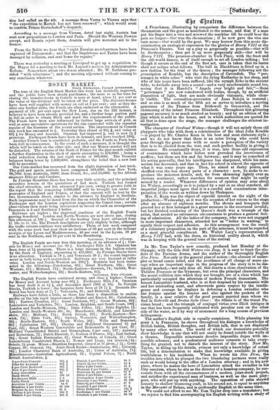int 4h1atrto.
A Frenchman, illustrating by comparison the difference between the rheumatism and the gout as manifested to the senses, said that if a man put his finger into a vice and screwed the machine till he could bear the pain no longer—that was the rheumatism ; if he now gave the vice one turn more—that would be the gout. We may borrow from this acute dis- crimination an analogical expression for the glories of Henry VIII at the Princess's Theatre. Get up a play as gorgeously as possible—that will be Sardanapalus ; then get it up more gorgeously still—that will be Henry VIII. The presence-chamber in York Place with the feast and the old-world dances is of itself enough to set all London talking ; but though it occurs at the end of the first act, care is taken that its lustre shall not eclipse what follows. The hall in Blackfriars is fitted up in a new fashion for the trial of the Queen ; the manager following not the prescription of liemble, but the description of Cavendish. The "per- sonages in white robes" who visit the dying Katharine in her sleep, and who of late years have been suffered, like the nymph Echo in the ancient fable, to dwindle away into a sound—and a very anachronistic sound too, seeing that it is Handel's "Angels ever bright and fair,"—these " personages" are now reendowed with bodies, though, by an artificial disposition of light, they are made obviously visionary, while clear- ly visible. The coronation-procession of Anne Boleyn is restored ; and so also is as much of the fifth act as serves to introduce a moving panorama of the Thames from Bridewell to Greenwich, and the christening of the infant Princess Elizabeth. Throughout this glittering pageant accuracy is as much studied as beauty ; and by an edition of the play which is sold in the house, and in which authorities are quoted for all that is done upon the stage, the manager challenges the strictest in- vestigation.
The character of Cardinal Fro:my—though it will not satisfy those old playgoers who take with them a reminiscence of the ideal John Kemble —is played by Mr. Charles Kean in his best and most elaborate style ; and we do not know that there is an actor living who could have gone through the great scene with so acute a perception of the variety that is to be elicited from the tett, and such perfect facility in giving it utterance. He occasionally drops, it is true, into those odd expressions of countenance which have before now provoked the irreverence of scoffers ; but these are few and far between ; and it may be remarked of his acting generally, that his intelligence has sharpened, while his man- nerism has decreased, and that in fact his school is almost the opposite of what it was some years ago. Then, he aimed at flashy points, and shuffled over the less showy parts of a character : now, he seeks to re- produce the minutest details, and, far from skimming lightly over an obvious sentiment, rather searches for nuances that might be easily missed by a reader. Whatever differences of opinion may arise about his Wolsey, accordingly as it is judged by a real or an ideal standard, all impartial judges must agree that it is a careful and conscientious inter- pretation of the words as written down by Shakspere. Mrs. C. Kean was the object of especial interest on the night of the production—Wednesday, as it was the occasion of her return to the stage after an absence of eighteen months. The shouts and bouquets that greeted her at first belonged in a great measure to the recovered invalid; but her finished rendering of the Queen's death was a triumph of the artist, that needed no extraneous circumstance to produce a general feel- ing of admiration. All the ladies of the company, who were not engaged in more important characters, attended her as "ladies in waiting,' to signify their respect and adhesion. As this arrangement was the result of a voluntary proposition on the part of the actresses, it must be regarded as a most graceful compliment. Mr. Walter Lacy's representation of Henry VIII had, with the dress, an historical reality about it, which was in keeping with the general tone of the revival.


























 Previous page
Previous page